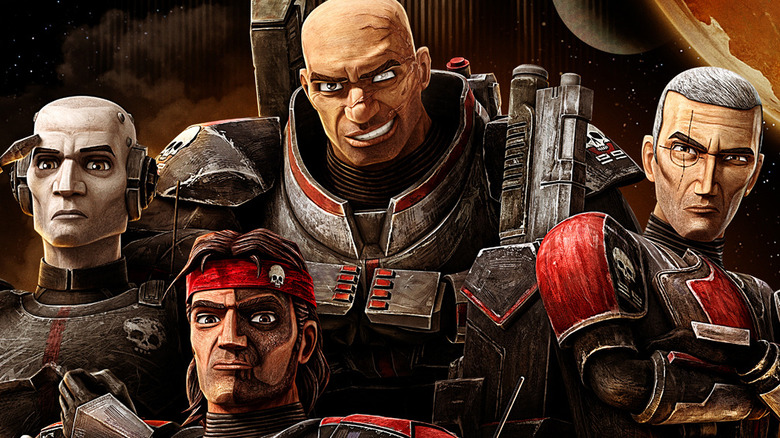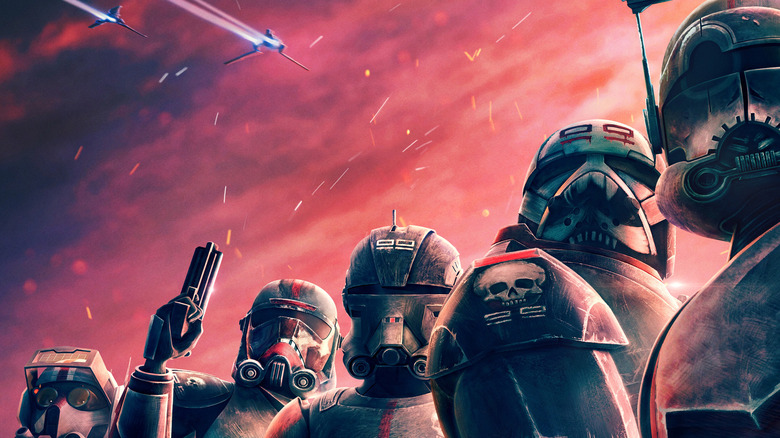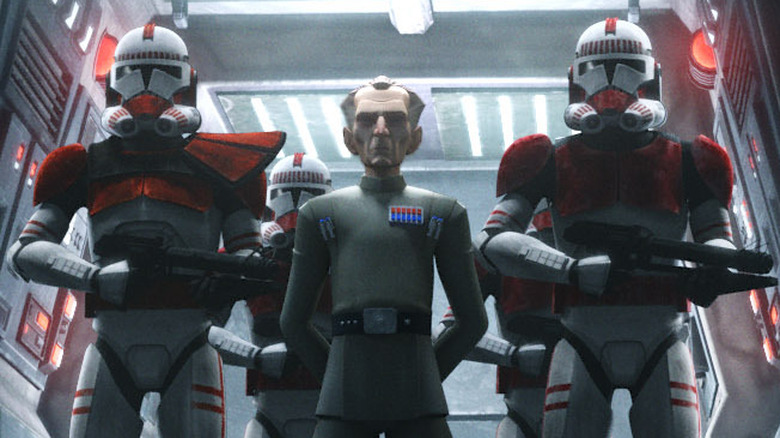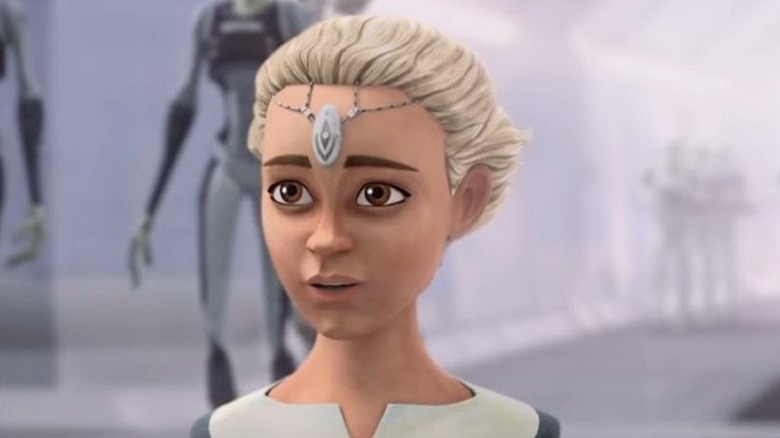Bad Batch Producers Jennifer Corbett And Brad Rau On Their Clone Squad, Tarkin, And Star Wars Animation - Exclusive Interview
After the decidedly... well, we'll call it a "mixed" reaction to the "Star Wars" prequel films, the franchise seemed for a bit to be without a way into the hearts of a new generation of fans. Enter Dave Filoni and the "Clone Wars" animated series. Kicking off with a feature film in 2008, "Clone Wars" added depth and breadth to the era explored in the prequels, recapturing the magic that made the original films so beloved. By the time it wrapped its original run in 2014 and gave way to "Rebels," it had introduced iconic characters like Ahsoka Tano and Asajj Ventress and established itself firmly in the "Star Wars" pantheon.
Perhaps one of the greatest accomplishments of "Clone Wars" was making what seemed like the franchise's most generic characters — the white-armored clone troopers — into interesting, individualized protagonists. This effort took another leap when, to the delight of fans everywhere, the series returned for a final season in 2020. In the first four episodes of that slate, the show introduced Clone Force 99, also known as the Bad Batch. This group of genetically talented super-soldiers was such a hit that they were spun off into their own series exploring the period immediately after the events of "Revenge of the Sith" under the guidance of franchise veterans Brad Rau and Jennifer Corbett.
With "The Bad Batch" arriving May 4 on Disney+, we sat down for an interview with Rau and Corbett to talk about the show's connection to the larger canon, its central villain and mysterious new protagonist, and the power of "Star Wars" animation.
The lure and legacy of Star Wars animation
The Bad Batch joins a long legacy of "Star Wars" animation. Why is this such a potent medium for telling stories in this universe?
Brad: Yeah, it's awesome. It's definitely cool to see "Star Wars" in the animated style, because honestly, to have the different kinds of characters that we have in "Star Wars" — humanoids, creatures, and droids, and the big ships and the action set pieces — to be able to have that stylistically in one non-realistic style gives you the suspension of disbelief, I think, that allows you to, in a way, almost get into it more. It's easier to pull off those bigger effects. Well, I wouldn't say easier; that's probably the wrong word. But budgetarily, it's easier to pull off those big action set pieces and then to have the style of our show, as we've pushed it over the years, to have the nuance of character, so we can see what the characters are thinking and get into that as much as we can. It's a really powerful thing. When you have that action and emotion working together, it feels like the right kind of "Star Wars."
Jennifer, did you have to take on why animation in "Star Wars" speaks to you?
Jennifer: For me, I think it's because, for series, all we had for so long was Lucasfilm animation, with "Clone Wars" and "Rebels," and then "Resistance." Those were stories that really spoke to me. And one of the reasons I became such a fan of Lucasfilm animation was because I was a diehard "Clone Wars" fan, and the content that was coming out of that series just blew my mind as a writer. And I was like, "How do I get on this show? It's so good."
For anyone who's coming into "The Bad Batch" only having seen the movies, or they're "Mandalorian" fans and are jumping over to the animated side, what would you say is the primer to get up to speed before they dive in?
Brad: I think honestly, even if a non-fan who has never seen "Star Wars" wants to get in on something, "The Bad Batch" is the perfect thing to start with, because we're talking about characters, "The Bad Batch" themselves, that we've only seen a little bit. The obvious answer is to watch the final season of "Clone Wars," where they're introduced, but that's the only time we've ever really seen them. They're new characters, so to take that idea and then go into this era that we've never really seen on film in any media is sort of this interesting, fresh start. We feel, if you're a big "Star Wars" fan, you're going to hopefully love it, but even if you don't know that much about "Star Wars," you can hit the ground running.
How The Bad Batch connects to Star Wars canon
What would you say is your favorite Easter egg or subtle reference in the first few episodes?
Jennifer: I think it's the fifth episode. I can't go into it, but I think that's my favorite Easter egg for diehard fans.
Brad: Yeah. I'll just say there are Easter eggs for diehard fans, but if we tell you what they are, they won't be Easter eggs.
You have this giant canon of characters with the animated series, with films, books, everything to draw from. How do you go about deciding what you're going to pick and choose to bring into this new series, and what character or reference are you most excited about bringing into "The Bad Batch"?
Jennifer: I mean, it's very tempting to want to play with all of the action figures, because there are so many out there in the galaxy right now, but we try to be very careful in who we choose and why, because we want to make sure it serves our characters' stories and isn't us just being fan service-y. Everything we do has a purpose. That being said, there may be some familiar faces. Obviously, we can't say who, but we hope that the fans get excited. Again, I can't tell you my favorite, because then that would be a spoiler.
Well, one familiar face we can talk about, because he's there right from the beginning, is Tarkin as your big bad. Can you talk a bit about the decision to bring that character in, and why you went with a familiar face for that role as opposed to something new?
Brad: Yeah, I mean, Tarkin is so bad in the best way. He's so good. And Stephen Stanton, who voices Tarkin, is so awesome. He's so great. Wanting to set the show up with a familiar face of evil makes a lot of sense. He seemed like the right choice for what's happening at the end of the Clone Wars at the beginning, and the rise of the Empire. It's kind of what Jen was saying. He serves a very specific point of view off of other characters. He's not just another action figure that we throw in there, but he is very purposeful when we see him. A lot of thought and talk went into him, along with any of the other characters that we might run across.
Jennifer: I think he's somebody who you immediately know where he's coming from. And when Palpatine takes over as Emperor, he's going to want to send a top general to handle things. So it seemed to make sense to have Tarkin be there for setting things in motion. And then, whether or not when he steps out ... because obviously, we know he goes on to bigger and better things, but it's his transition, too. He's transitioning from the Republic to the Empire and doing things in order to get more power. But it felt like a seamless idea, really, to have him be there for that.
The Bad Batch's Omega and how she stacks up to another Star Wars child
One of the biggest stories in "Star Wars" in recent times has been Grogu, with "The Mandalorian." We had this character who comes from this hardened fighting background connecting with a young ward with mysterious powers. Can you draw a bit of a contrast between that and the role of the clone child Omega on "The Bad Batch"?
Jennifer: I think there are some similarities there, but if you think about these characters, they're obviously very different. Mando, in those flashbacks in which we saw him, he had parents. And he had a childhood before the purge and when things went really bad, but he had that experience. I think that affects how he relates, at least from when I watch it, to Grogu.
With the Bad Batch, they're clones who were created and then trained and were never really children. And their only purpose in life was to be soldiers for the Republic, so they have a very narrow view of the galaxy beyond being a soldier. And then Omega has a completely different perspective, because even though she was raised on Camino, it's all she's known. So she knows science, she knows Camino, but she hasn't set foot anywhere else. It's kind of like both groups are just fish out of water. And I think that they help each other grow in these adventures that they go on.
Brad: You take this motley crew, this motley family, and you throw them into a situation where now they got to ... they're hungry. Now what do they do? That's different. That's not a mission objective. That's where I think we get some interesting differences from things you've seen in other shows like "The Mandalorian."
"The Bad Batch" arrives on Disney+ on May 4.



